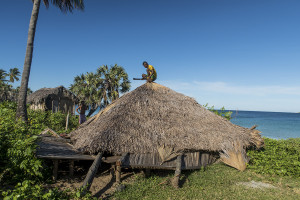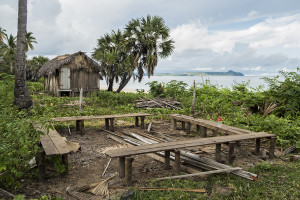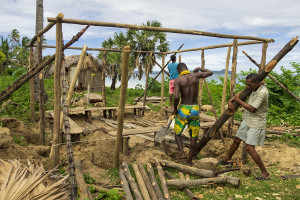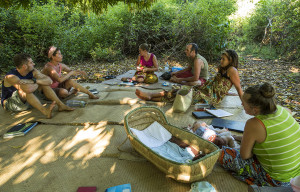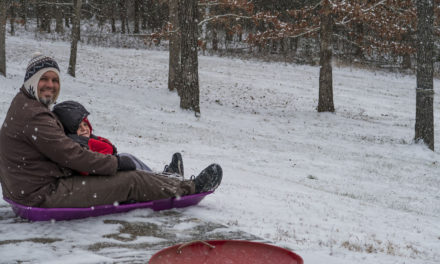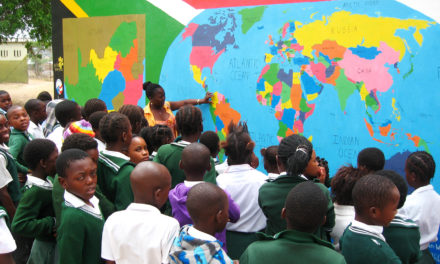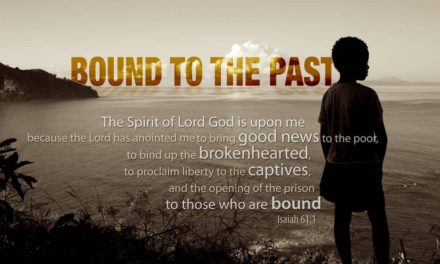A s I was guiding our boat to shore, the passengers started pointing towards our village and shouting out, “what’s that?” “What happened!?” “Something looks wrong!” Rising from the ground next to our house was the peak of a roof. Still a fair distance from shore, it wasn’t immediately obvious what had happened. But it was obvious that our team’s meeting hut was a lot shorter than it used to be.
Once we got to shore and unloaded most of our luggage, we got a chance to inspect it all more closely. Our meeting hut had completely collapsed, falling down westward. Some posts had been ripped out of the ground, but most were simply snapped in half. The roof appeared mostly intact, but the support beams were sticking through it in one place or another. Only the benches (not connected to the main structure) were still standing. Three days before our return, a strong, sustained east wind had blown it over.
Truthfully, I wasn’t too surprised. Very disappointed, for sure. But not that surprised. Before we headed to the mainland on our most recent supply run, our meeting hut had already begun to lean a bit. During several days of strong west wind, it was leaning northeastward and the whole structure was shaking quite a lot. We and several others in our village began to tie ropes and boards to our roofs, anything we could find, to keep the thatching and other parts from blowing away in the strong winds. When there was a break in the weather, I looked closely at the team meeting hut and noticed that several of the main support posts had rotted under the ground and they were beginning to crack at ground level. At that time I got several men in our village to help me push the hut back upright and we tied the corners of the structure to a nearby tree and to several posts we drove into the ground.
The hope was that we could keep our team meeting hut standing long enough that we could replace the rotten support posts with new ones, and thus keep the whole thing standing through another windy season. During our supply run on the mainland, we fetched the carpenter who did the primary work in building all of our team’s huts the first time. He thought it would be a quick and easy fix to replace those rotten support posts and he was willing to help. But as we pulled up to shore that day and saw that the whole thing had collapsed while we were gone, we began to realize that it wouldn’t just be a simple fix. It turned out we’d have to rebuild the entire thing from scratch, from the ground up and with almost all new materials.
The carpenter, his co-worker, and I assessed the damage and began to make a plan for starting over. If we were going to have to build it all over again, we definitely wanted something stronger the second time around. During the process, I learned that the primary support beams used to build the hut the first time were “male mangrove” (to translate it literally) and that that particular type of wood rots a bit easily when exposed to water in the ground. The cement reinforcing the posts underground did little to prevent the water rot. There were also only three support poles per side – not a lot. In contrast, our own house was built with “female mangrove” (the more water-resistant variety) and was built with more primary support beams and closer together – and thus the high winds were unable to affect it. Without the strong winds, our meeting hut might not have fallen down. But it also wasn’t built very firmly to begin with and the chosen materials weren’t great. A few weeks before when I first began to see the water rot cracking the posts at ground level, I knew it wouldn’t be long before the structure fell over on its own.
So, that’s a somewhat technical explanation for something you may not even care about. But all of this got me thinking about what it takes to build something that lasts. Of course, the obvious first example that comes to mind is Jesus’ parable about the wise man building his house on rock and the foolish man building his house on sand. (Matthew 7:24-27) Well, we’ve already lost that one because, just like our neighbors, all of our homes are built on sand. You can’t really help it when all of the villages are along the beach. Just like the foolish man in the parable, the strong winds were what eventually brought our meeting hut down. That and the fact that our foundational supports were too weak to stand against the storm. So what can we do to make it stronger?
W hat we’re attempting here among the Antakarana on Nosy Mitsio is very much the same as building something new. In Romans 15:20, where Paul talks about proclaiming the Good News where Christ has not yet been named, he describes it as building a new foundation. We’re working with God to establish the foundations of his Kingdom where it’s not yet been evident. We’re breaking new ground. And to the Corinthian church, Paul says he laid a foundation like a skilled master builder (1 Cor 3:1). He proclaims that the foundation itself is Jesus the Christ!
So how does that foundation get translated into Antakarana language and culture? Not easily! Not quickly! We’ve been on the ground making efforts among the Antakarana here for nearly three straight years now, and I still often feel like we’ve barely just begun. There are times when I get frustrated with how slow this process is, with how little progress we’ve appeared to make. I get tempted to rush it somehow, to shortcut in one area or another, to find some way to speed things up even at the expense of assured quality. I feel like it’s time to see some results! We’re here to bring the Antakarana people into the Kingdom of God, so surely after so long, it’s time to bring them in!
But during the last few weeks I’ve been able to look at the ruined mess next to our house and be reminded of the results of building on a weak foundation. The supporting posts, those that are the foundation of the structure, have to be carefully chosen. And you need enough of them, even more than enough! If you have just a few of them, you might save some time and effort and you might get the structure standing sooner than later. But it won’t last very long. Eventually some strong wind or rain will pick up and blow the whole thing down.
There’s no substitute for the meticulous selection and preparation of the foundation. If the foundation is Jesus himself, then we can’t present some slipshod and rushed-over version of him and hope that it will endure the test of time, that it will outlast all the storms of life that will surely blow. More likely, as soon as we’re away for a week or two, the whole thing will come crashing down. Jesus spent years with his disciples, preparing them for the day of his departure. And that was after they already spoke the same language and shared the same culture! Even then, many of them were shocked and confused when he left. But through his years of discipleship, the strength of the community he’d formed them into, and the power of the Holy Spirit he’d sent to guide them, the foundation survived. And the resulting life of the Church has changed the world!
Our goal here isn’t to build one Antakarana church of our neighbors and friends, though that would be nice. If that were our goal, then maybe the foundations wouldn’t have to be too strong, if the resulting structure will never be too large. Maybe we’d be finished by now and already have something nice to look at.
But instead, our goal is to build the foundations for the Antakarana church that will have the strength and endurance to grow and reproduce and transform whole communities, the entire Antakarana tribal group, and all they come into contact with. Only the firmest and most flawless foundations can withstand that weight. And so, like Paul, we need to become skilled master builders.
W ith that goal in mind, we’ve spent the previous months and years working away at the hard ground. Initially, it was difficult enough just to chip the hard surface with a shovel. (I’m speaking metaphorically here, since most the ground is actually sand.) But we persisted; we joined the local life and we learned the local dialect. The ground began to soften. We brought in a team to do the same thing, but now spread out among multiple villages. Together we’ve spent the months and years working away at learning the in’s and out’s of daily life, the nuances of the language, the particulars of the culture, and the hopes and fears of the people. Now the ground is soft.

This is one of our friends who’s gone from seemingly afraid of prayer to being eager to participate.
Every day now, us and our team members have opportunities to share our trust in the goodness of God, in the grace provided through Jesus, and in our confidence that he is deeply and truly interested in pouring out his goodness into our lives here, into the Antakarana people themselves. When a neighbor is possessed by a spirit and oppressed by their demands, we can confidently proclaim protection from all such spirits, through the goodness of God’s Holy Spirit. And some of our friends respond saying that they also want to trust God for protection. When someone is sick or injured, we can encourage trust in God’s redemption through prayer and healing, both supernatural and natural. And some of our friends proudly share the news that God answered prayer and healed them.
None of these things were possible at the beginning, when people laughed at prayer or quickly ended conversations that drifted towards belief in anything other than the ancestors. Honestly, we could barely communicate in any of these areas back then anyway. But now the ground is soft. Now is the time for us to choose where to dig, to carefully select our materials, to prepare them and position them, and to lay the firm foundation of Jesus on which the Antakarana church can endure, grow, and multiply.
I still get frustrated sometimes with how slow this whole process is, especially now that we see the ground is soft and ready. I want to build already! But we’re still selecting our materials, testing them for quality and endurance. If they’re not suited to the ground here, then we can’t expect the structure to last.
The culture and faith of the Antakarana people is one that believes the Creator God is disinterested and distant, that he passed most of his power onto the ancestors, who themselves can interfere at any moment in the lives of the people around them, mostly to cause sickness and curses and to construct elaborate and innumerable taboos that constrict the lives of their descendants. This is the ground we’re working with, and to these things and more we have to respond in order to lay a strong and enduring foundation for the Antakarana church. We’re trying to choose carefully on how to respond to each of these aspects of their culture and religious heritage. In what ways are God’s creation truths still evident among the Antakarana? And in what ways is God seeking to redeem the areas in which they’ve strayed far away?
So we’re selecting Bible stories, we’re translating them, and we’re testing them (the hardest part!) to be sure there are no inadvertent communications and that even the storytelling style itself is one which is memorable and repeatable. For how else can the Antakarana church endure and grow during our absence? I want to begin teaching from these Bible stories now, before they’re even finished. But we have to lay a firm foundation. And when the stories are ready, we’ll then have to use them to lay the foundation in such a way that it’s not us foreign missionaries supporting the whole structure, but that it’s Christ himself. Though it would be easier to simply teach from the stories we’re preparing, instead we need to train the Antakarana people to learn the truths of the Bible from the Teacher himself, the Holy Spirit. For how else can they endure and grow in our absence? We want to lay the same foundation that Jesus himself laid for his disciples, before his long absence. We know that’s the right one, the one on which the Church is built that can change the world.
Soon (we hope), the foundational materials will be ready and we can start rejoicing in what is built by the power of the Holy Spirit.
T hough our homes here are all built on the sand (of necessity), we want to be sure that the Antakarana church is planted firmly upon the rock. In Matthew 16, when Peter declared to Jesus, in his own language, that Jesus is the Messiah, the promised one, the Liberating King – the answer to all the hopes and expectations of the Jewish people, Jesus responded,
We pray that the foundation we’re laying is one in which the Antakarana people can find in Jesus the fulfillment of their deepest desires, freedom from the spirits which oppress them, and the answer to all their hopes and expectations. And we pray that they can make this proclamation in their own language and through their own culture. Please pray with us.
In Christ,
Adam, Lora, Matimu and David Willard
P.S. In the time since our meeting hut fell down, our carpenter friend and his co-workers have rebuilt it. This time with (slightly) better materials, more supporting posts, and a revised design that should also make it a bit sturdier. During the process, we were also able to make an attempt at transforming an ancestral ritual into one which glorifies Christ.
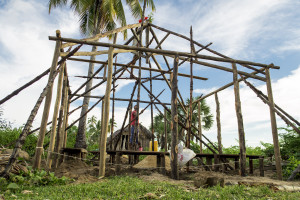
This is when our carpenter friend dedicated our new team meeting hut to God instead of to the ancestors, the very first time it’s ever happened on Nosy Mitsio.
Normally, on the first day any new structure is erected, the builders will pour on the top of it a sweet drink as a sacrifice to the ancestors (as a way of asking for them not to curse the inhabitants of the building), and they’ll tie a flower to its highest beam. It’s unthinkable for local people to build a home without performing this ritual, and they’re afraid that many people will be cursed if they don’t. So we talked to the carpenter and asked him to share part of the story of Jesus as he performed this. As he climbed to the top and tied the flowers, instead of speaking to the ancestors as would be common, he announced to everyone present that the living thing is there to acknowledge God who has created all, and that the juice poured out is in remembrance of Jesus’s blood poured out, through whose sacrifice and resurrection we already have the blessings of God. Perhaps it was all a hasty substitution for their ancestral rituals, and certainly we weren’t given much time to think it through. But it’s in this way that a firm foundation for the Antakarana church needs to carefully respond to the ground in which it’s built.
Please pray with us that our new meeting hut will stand firm. And that in some way, being the first building on Nosy Mitsio dedicated to God rather than to the ancestors, that it may be a testament to the beginnings of the Good News being announced to the Antakarana people – and to the enduring power of God’s love and grace as we know him in Jesus.

Our newly rebuilt team meeting hut in front of a beautiful Nosy Mitsio sunset. We believe good things are on their way!
An edited/formatted version of this article can be found on AIM US’s website here: http://aimstories.com/blog/2016/06/firm-foundations/

